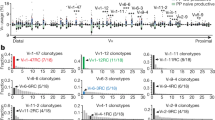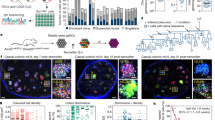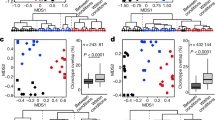Abstract
The RAG1/RAG2 endonuclease (RAG) initiates the V(D)J recombination reaction that assembles immunoglobulin heavy (IgH) and light (IgL) chain variable region exons from germline gene segments to generate primary antibody repertoires1. IgH V(D)J assembly occurs in progenitor (pro-) B cells followed by that of IgL in precursor (pre-) B cells. Expression of IgH μ and IgL (Igκ or Igλ) chains generates IgM, which is expressed on immature B cells as the B-cell antigen-binding receptor (BCR). Rag expression can continue in immature B cells2, allowing continued Igκ V(D)J recombination that replaces the initial VκJκ exon with one that generates a new specificity3,4,5. This ‘receptor editing’ process, which can also lead to Igλ V(D)J recombination and expression3,6,7, provides a mechanism whereby antigen encounter at the Rag-expressing immature B-cell stage helps shape pre-immune BCR repertoires. As the major site of postnatal B-cell development, the bone marrow is the principal location of primary immunoglobulin repertoire diversification in mice. Here we report that early B-cell development also occurs within the mouse intestinal lamina propria (LP), where the associated V(D)J recombination/receptor editing processes modulate primary LP immunoglobulin repertoires. At weanling age in normally housed mice, the LP contains a population of Rag-expressing B-lineage cells that harbour intermediates indicative of ongoing V(D)J recombination and which contain cells with pro-B, pre-B and editing phenotypes. Consistent with LP-specific receptor editing, Rag-expressing LP B-lineage cells have similar VH repertoires, but significantly different Vκ repertoires, compared to those of Rag2-expressing bone marrow counterparts. Moreover, colonization of germ-free mice leads to an increased ratio of Igλ-expressing versus Igκ-expressing B cells specifically in the LP. We conclude that B-cell development occurs in the intestinal mucosa, where it is regulated by extracellular signals from commensal microbes that influence gut immunoglobulin repertoires.
This is a preview of subscription content, access via your institution
Access options
Subscribe to this journal
Receive 51 print issues and online access
$199.00 per year
only $3.90 per issue
Buy this article
- Purchase on Springer Link
- Instant access to full article PDF
Prices may be subject to local taxes which are calculated during checkout




Similar content being viewed by others
Accession codes
References
Jung, D., Giallourakis, C., Mostoslavsky, R. & Alt, F. W. Mechanism and control of V(D)J recombination at the immunoglobulin heavy chain locus. Annu. Rev. Immunol. 24, 541–570 (2006)
Yu, W. et al. Continued RAG expression in late stages of B cell development and no apparent re-induction after immunization. Nature 400, 682–687 (1999)
Tiegs, S. L., Russell, D. M. & Nemazee, D. Receptor editing in self-reactive bone marrow B cells. J. Exp. Med. 177, 1009–1020 (1993)
Gay, D., Saunders, T., Camper, S. & Weigert, M. Receptor editing: an approach by autoreactive B cells to escape tolerance. J. Exp. Med. 177, 999–1008 (1993)
Pelanda, R. et al. Receptor editing in a transgenic mouse model: site, efficiency, and role in B cell tolerance and antibody diversification. Immunity 7, 765–775 (1997)
Retter, M. W. & Nemazee, D. Receptor editing occurs frequently during normal B cell development. J. Exp. Med. 188, 1231–1238 (1998)
Hertz, M. & Nemazee, D. BCR ligation induces receptor editing in IgM+IgD− bone marrow B cells in vitro. Immunity 6, 429–436 (1997)
Lanning, D., Zhu, X., Zhai, S. K. & Knight, K. L. Development of the antibody repertoire in rabbit: gut-associated lymphoid tissue, microbes, and selection. Immunol. Rev. 175, 214–228 (2000)
Jenne, C. N., Kennedy, L. J. & Reynolds, J. D. Antibody repertoire development in the sheep. Dev. Comp. Immunol. 30, 165–174 (2006)
Ratcliffe, M. J. Antibodies, immunoglobulin genes and the bursa of Fabricius in chicken B cell development. Dev. Comp. Immunol. 30, 101–118 (2006)
Lanning, D. K., Rhee, K. J. & Knight, K. L. Intestinal bacteria and development of the B-lymphocyte repertoire. Trends Immunol. 26, 419–425 (2005)
Butler, J. E. et al. Antibody repertoire development in fetal and neonatal piglets. VIII. Colonization is required for newborn piglets to make serum antibodies to T-dependent and type 2 T-independent antigens. J. Immunol. 169, 6822–6830 (2002)
Wang, J. H. et al. Mechanisms promoting translocations in editing and switching peripheral B cells. Nature 460, 231–236 (2009)
Wang, J. H. et al. Oncogenic transformation in the absence of Xrcc4 targets peripheral B cells that have undergone editing and switching. J. Exp. Med. 205, 3079–3090 (2008)
Monroe, R. J. et al. RAG2:GFP knockin mice reveal novel aspects of RAG2 expression in primary and peripheral lymphoid tissues. Immunity 11, 201–212 (1999)
Nagaoka, H., Yu, W. & Nussenzweig, M. C. Regulation of RAG expression in developing lymphocytes. Curr. Opin. Immunol. 12, 187–190 (2000)
Nagaoka, H., Gonzalez-Aseguinolaza, G., Tsuji, M. & Nussenzweig, M. C. Immunization and infection change the number of recombination activating gene (RAG)-expressing B cells in the periphery by altering immature lymphocyte production. J. Exp. Med. 191, 2113–2120 (2000)
Gärtner, F., Alt, F. W., Monroe, R. J. & Seidl, K. J. Antigen-independent appearance of recombination activating gene (Rag)-positive bone marrow B cells in the spleens of immunized mice. J. Exp. Med. 192, 1745–1754 (2000)
Ueda, Y., Yang, K., Foster, S. J., Kondo, M. & Kelsoe, G. Inflammation controls B lymphopoiesis by regulating chemokine CXCL12 expression. J. Exp. Med. 199, 47–58 (2004)
Jankovic, M., Casellas, R., Yannoutsos, N., Wardemann, H. & Nussenzweig, M. C. RAGs and regulation of autoantibodies. Annu. Rev. Immunol. 22, 485–501 (2004)
Raff, M. C., Megson, M., Owen, J. J. & Cooper, M. D. Early production of intracellular IgM by B-lymphocyte precursors in mouse. Nature 259, 224–226 (1976)
Desiderio, S. V. et al. Insertion of N regions into heavy-chain genes is correlated with expression of terminal deoxytransferase in B cells. Nature 311, 752–755 (1984)
Golby, S. et al. B cell development and proliferation of mature B cells in human fetal intestine. J. Leukoc. Biol. 72, 279–284 (2002)
Hooper, L. V., Littman, D. R. & Macpherson, A. J. Interactions between the microbiota and the immune system. Science 336, 1268–1273 (2012)
Mackie, R. I., Sghir, A. & Gaskins, H. R. Developmental microbial ecology of the neonatal gastrointestinal tract. Am. J. Clin. Nutr. 69, 1035S–1045S (1999)
Ueda, Y., Liao, D., Yang, K., Patel, A. & Kelsoe, G. T-independent activation-induced cytidine deaminase expression, class-switch recombination, and antibody production by immature/transitional 1 B cells. J. Immunol. 178, 3593–3601 (2007)
Lefrancois, L. & Lycke, N. Isolation of mouse small intestinal intraepithelial lymphocytes, Peyer’s patch, and lamina propria cells. Curr. Protoc. Immunol. Ch. 3, Unit 3.19. (2001)
Reich, M. et al. GenePattern 2.0. Nature Genet. 38, 500–501 (2006)
Warren, R. L. et al. Exhaustive T-cell repertoire sequencing of human peripheral blood samples reveals signatures of antigen selection and a directly measured repertoire size of at least 1 million clonotypes. Genome Res. 21, 790–797 (2011)
Kepler, T. B. Reconstructing a B-cell clonal lineage. I. Statistical inference of unobserved ancestors [v1; ref status: indexed, http://f1000r.es/z6] F1000 Res. 2, 103 (2013)
Acknowledgements
This work was supported by National Institutes of Health grants AI020047 (to F.W.A.) and AI89972 (to D.R.W.), Lymphoma and Leukemia SCOR 7009-12 (to F.W.A.), and National Institutes of Health research contract HHSN272201000053C (to T.B.K.). D.R.W. was also supported by an award from the American Academy of Allergy Asthma and Immunology and CSL-Behring and holds a Career Award for Medical Scientists from the Burroughs Wellcome Fund. F.W.A. is an Investigator of the Howard Hughes Medical Institute.
Author information
Authors and Affiliations
Contributions
D.R.W. and F.W.A. designed the study; D.R.W., A.J.P., M.P.G., K.C.-J., J.M.M. and R.A.P. performed experiments; R.M.M. and T.B.K. performed computational analysis of sequencing data; S.J.R. performed immunohistochemistry experiments; D.R.W. and F.W.A. wrote the paper.
Corresponding authors
Ethics declarations
Competing interests
The authors declare no competing financial interests.
Supplementary information
Supplementary Information
This file contains Supplementary Figures 1-18 and additional references. (PDF 27346 kb)
Rights and permissions
About this article
Cite this article
Wesemann, D., Portuguese, A., Meyers, R. et al. Microbial colonization influences early B-lineage development in the gut lamina propria. Nature 501, 112–115 (2013). https://doi.org/10.1038/nature12496
Received:
Accepted:
Published:
Issue Date:
DOI: https://doi.org/10.1038/nature12496
This article is cited by
-
The impact of the gut microbiome on tumor immunotherapy: from mechanism to application strategies
Cell & Bioscience (2023)
-
Bacteroides-derived isovaleric acid enhances mucosal immunity by facilitating intestinal IgA response in broilers
Journal of Animal Science and Biotechnology (2023)
-
Pathogenesis of allergic diseases and implications for therapeutic interventions
Signal Transduction and Targeted Therapy (2023)
-
Peripheral immune cells and perinatal brain injury: a double-edged sword?
Pediatric Research (2022)
-
The crosstalk between intestinal bacterial microbiota and immune cells in colorectal cancer progression
Clinical and Translational Oncology (2022)
Comments
By submitting a comment you agree to abide by our Terms and Community Guidelines. If you find something abusive or that does not comply with our terms or guidelines please flag it as inappropriate.



